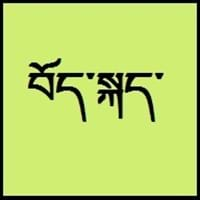Countries
China, Nepal
China, Mongolia
National Language
Nepal, Tibet
China, Mongolia
Second Language
Not spoken in any of the countries
Not spoken in any of the countries
Speaking Continents
Asia
Asia
Minority Language
China, India, Nepal
Not spoken in any of the countries
Regulated By
Committee for the Standardisation of the Tibetan Language
Council for Language and Literature Work, State Language Council (Mongolia)
Interesting Facts
- Tibetan dialects vary alot, so it's difficult for tibetans to understand each other if they are not from same area.
- Tibetan is tonal with six tones in all: short low, long low, high falling, low falling, short high, long high.
- Mongolian was first written using Phagspa script in late 13th century.
- There is no connection between Mongolian, Japanese and Korean, but still in terms of grammar and sentence structure they are very similar.
Similar To
Not Available
Turkish Language
Derived From
Not Available
Not Available
Alphabets in
Tibetan-Alphabets.jpg#200
Mongolian-Alphabets.jpg#200
Scripts
Tibetan alphabet, Tibetan Braille
Mongolian alphabets: Traditional Mongolian script
Writing Direction
Left-To-Right, Horizontal
Not Available
Hello
བཀྲ་ཤིས་བདེ་ལེགས། (tashi delek)
Сайн уу (Sain uu)
Thank You
ཐུགས་རྗེ་ཆེ་། (tujay-chay)
та бүхэнд баярлалаа (ta bükhend bayarlalaa)
How Are You?
ཁྱེད་རང་སྐུ་གཇུགས་བདེ་པོ་ཡིན་པས།
(kayrang kusu debo yimbay?)
Юу байна? (Yuu baina?)
Good Night
གཟིམ་ལཇག་གནང་དགོས་། (sim-jah nahng-go)
Сайн шөнийн (Sain shöniin)
Good Evening
དགོང་དྲོ་བདེ་ལེགས།
Сайн үдэш (Sain üdesh)
Good Afternoon
ཉིན་གུང་བདེ་ལེགས།
Сайн Үдээс хойш (Sain Üdees khoish)
Good Morning
སྔ་དྲོ་བདེ་ལེགས། (nga-to delek)
Өглөөний мэнд (Öglöönii mend)
Please
thu-je zig / ku-chee.
Хэрэв (Kherev)
Sorry
ཀོང་དགས་། (gawn-da)
Уучлаарай (Uuchlaarai)
Bye
ག་ལེར་ཕེབས་། (kha-leh phe)
Баяртай (Bayartai)
I Love You
ང་ཁྱེད་རང་ལ་དགའ་པོ་ཡོད་ (nga kayrâng-la gawpo yö)
Би чамд хайртай (Bi chamd khairtai)
Excuse Me
དགོངས་དག བཟོད་དུ་གསོལ། ཐུགས་རྗེ་གཟིགས།
Өршөөгөөрэй (Örshöögöörei)
Dialect 1
Central Tibetan
Khalkha Mongolian
Where They Speak
China, India, Nepal
Mongolia
How Many People Speak
Not Available
Dialect 2
Khams Tibetan
Ordos Mongolian
Where They Speak
Bhutan, China
Mongolia
Dialect 3
Amdo Tibetan
Khorchin Mongolian
Where They Speak
China
Mongolia
How Many People Speak
Not Available
Speaking Population
Not Available
Not Available
Native Name
བོད་སྐད་ (pö-gay)
монгол (mongol) монгол хэл (mongol hêl)
Alternative Names
Bhotia, Dbus, Dbusgtsang, Phoke, Tibetan, U, Wei, Weizang, Zang
Not Available
French Name
tibétain
mongol
German Name
Tibetisch
Mongolisch
Pronunciation
Not Available
/mɔŋɢɔ̆ɮ xiɮ/
Ethnicity
tibetan people
Not Available
Language Family
Sino-Tibetan Family
Mongolic family
Subgroup
Tibeto-Burman
Mongolian
Branch
Not Available
Not Available
Early Forms
Old Tibetan, Classical Tibetan
Middle Mongolian, Classical Mongolian, Mongolian
Standard Forms
Standard Tibetan
Khalkha, Southern Mongolian
Signed Forms
Tibetan Sign Language
Mongolian Sign Language
Scope
Not Available
Macrolanguage
ISO 639 6
Not Available
Not Available
Glottocode
tibe1272
mong1331
Linguasphere
No data Available
part of 44-BAA-b
Language Type
Not Available
Living
Language Linguistic Typology
Not Available
Subject-Object-Verb
Language Morphological Typology
Not Available
Not Available
Tibetan and Mongolian Greetings
People around the world use different languages to interact with each other. Even if we cannot communicate fluently in any language, it will always be beneficial to know about some of the common greetings or phrases from that language. This is where Tibetan and Mongolian greetings helps you to understand basic phrases in Tibetan and Mongolian language. Tibetan word for "Hello" is བཀྲ་ཤིས་བདེ་ལེགས། (tashi delek) or Mongolian word for "Thank You" is та бүхэнд баярлалаа (ta bükhend bayarlalaa). Find more of such common Tibetan Greetings and Mongolian Greetings. These greetings will help you to be more confident when conversing with natives that speak these languages.
Tibetan vs Mongolian Difficulty
The Tibetan vs Mongolian difficulty level basically depends on the number of Tibetan Alphabets and Mongolian Alphabets. Also the number of vowels and consonants in the language plays an important role in deciding the difficulty level of that language. The important points to be considered when we compare Tibetan and Mongolian are the origin, speaking countries, language family, different greetings, speaking population of these languages. Want to know in Tibetan and Mongolian, which language is harder to learn? Time required to learn Tibetan is 24 weeks while to learn Mongolian time required is 44 weeks.





